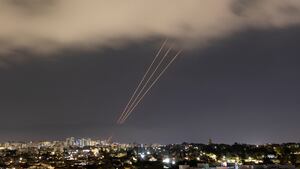Among the weapons Iran used in its unprecedented attack on Israel on April 13 were approximately 170 armed one-way attack drones. This was part of a barrage of about 350 drones and missiles.
And while nearly all of them were shot down before reaching their targets in Israel, Iran has increasingly relied on these types of “kamikaze” drones—which now represent a much larger threat to global security. Iran has exported its delta-wing style Shahed 136 drones to Russia, where they have been used to terrorize Ukrainian cities.
Iran’s path to becoming a drone superpower goes back to the 1980s, when Iran’s new regime emerged from the Islamic Revolution without a large enough air force to fight the Iran-Iraq war. It tapped into using small remote-piloted aircraft, basically what we now know as drones, to carry out surveillance missions on the front line.
At the time, these simple machines—slightly larger than a large model airplane—could help bring back photos from the front. And if they were shot down, it was no great loss to Iran, as they were cheap and expendable.
In the last decade, Iran has focused its investment on new types of drones. Instead of only trying to copy expensive successful drones—such as the American-made Predator and Reaper that became common during the global war on terror after 9/11—Tehran has invested in cheap, simple drones that can be used as a kind of instant air force.
This makes sense for Iran, because it is under international sanctions and can’t produce complex military aircraft. However, what Iran has learned is that one doesn’t need billion-dollar warplanes to fight modern wars. The Shahed-type drones have been used by Iran to carry out attacks on Saudi Arabia’s largest energy facility in 2019, as well as to target Kurdish dissidents in northern Iraq and to target Israel.
Iran first used a drone to target Israel from Syria in Feb. 2018. Tehran also exported drones and technology to the Houthis in Yemen and Iranian-backed militias in Iraq and Syria. These kamikaze-type drones have also been used to target U.S. forces in Iraq, Syria, and Jordan. In April 2021 an Iranian-backed militia in Iraq used drones to target a hangar reportedly)" href="https://urldefense.com/v3/__https://www.washingtonpost.com/world/middle_east/iraq-militia-drones-threat/2021/05/28/864e44d0-bc8f-11eb-922a-c40c9774bc48_story.html__;!!LsXw!RESJBb3y2VhD6Mjr89JcCV1rPifN4YjNp-MJH9mGT8C1XHwniq97a1DNZ6PBhLaV_ZN6MtEeNy_8zrs0CGmpt48$">reportedly used by the CIA at Erbil International Airport. On Jan. 27 of this year, a drone was used to kill three U.S. service members in Jordan.
The emerging threat has now exploded exponentially in the Middle East and globally. The attacks on Ukraine by Russia using drones are one front where drones are revolutionizing the battlefield. This not only includes Iranian-style kamikaze drones but also a plethora of other types of drones by Russia and Ukraine, including unmanned vessels that explode on impact.
The difficulty countries face in countering these weapons is that air defenses in recent years have been dominated by relatively expensive systems—such as the U.S. Patriot, or Israeli systems such as the Arrow and David’s Sling (which were jointly developed with the U.S.), and the Iron Dome system.
Smaller one-way drones—which are about three meters long and two meters wide—can be shot down by air defenses. They also fly so slowly that warplanes can be sent up to shoot them down the way one would shoot down a hostile aircraft.
However, as Iran showed on April 13 and April 14, these drones can be mass-produced and flown in large quantities toward a target, attacking from a variety of directions. During the interception of the Iranian drones, the forces of Israel, France, the U.K., the U.S., Jordan, and other countries helped down the drones—an unprecedented number of countries coming together to fight a thousand-mile duel in the skies over the Middle East. The success in stopping the Iranian drones should not be taken for granted. These weapons are spreading havoc and they are growing in number exponentially.
It was only a few years ago that Iran carried out attacks using a solitary drone, such as in Feb. 2018 against Israel. It later fired about two dozen against Saudi Arabia.
But in this weekend’s foiled attack, Iran showed it can launch 170 at a time from multiple fronts. The game has changed.
Seth J. Frantzman is the author of Drone Wars: Pioneers, Killing Machines, Artificial Intelligence, and the Battle for the Future, and an adjunct Fellow at The Foundation for Defense of Democracies.









